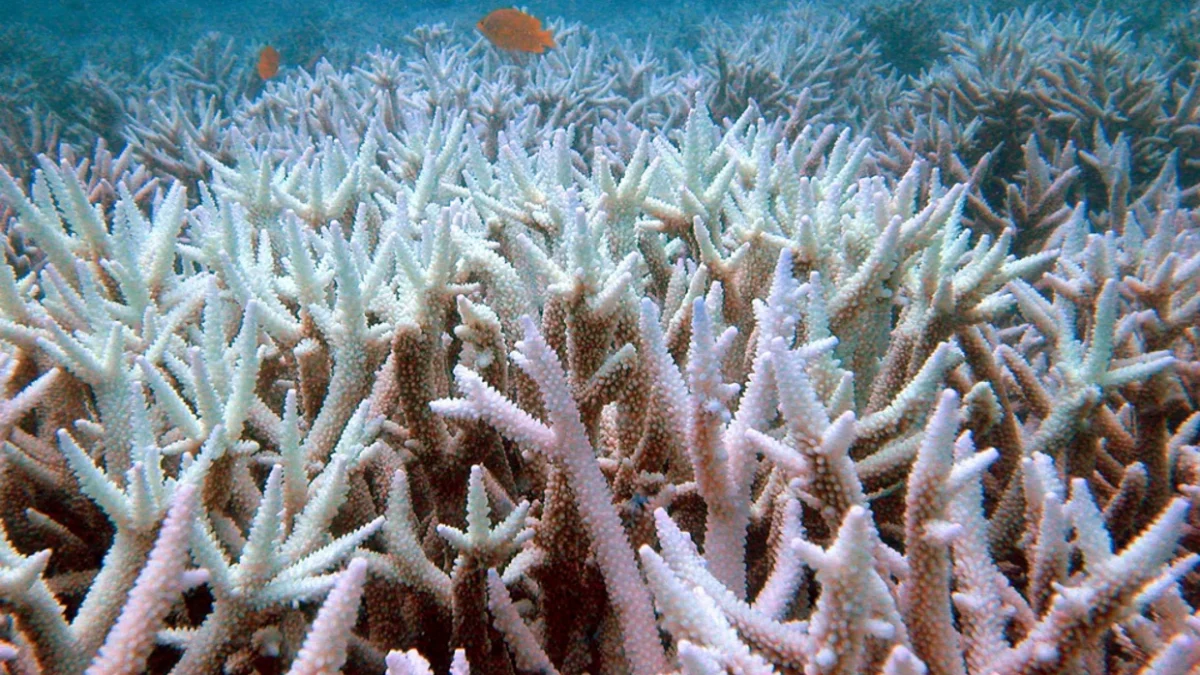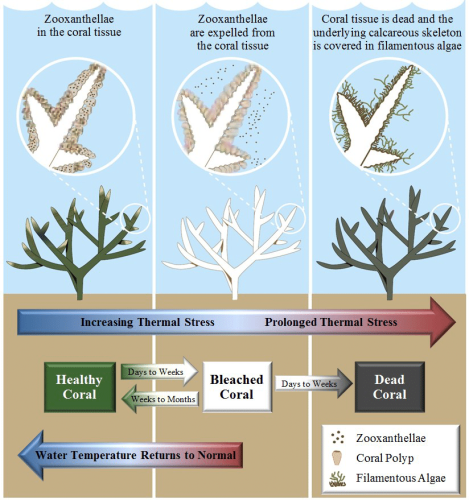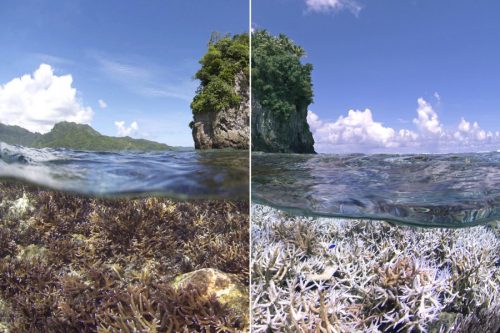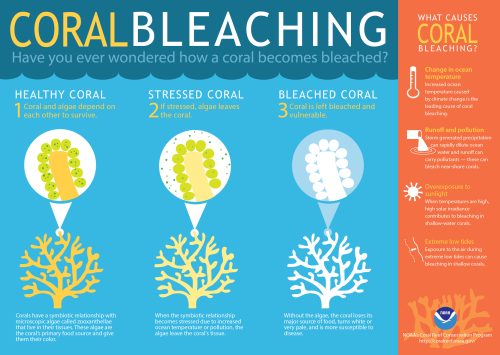The Gorgeous Colors of Coral Reefs, Don’t Let Them be White!

Photo Credit : Ove Hoegh-Guldberg/Centre for Marine Studies
Coral reefs are geological structures formed from collections of living organisms called coral polyps. Coral reefs consist of calcium carbonate skeletons built by coral polyps that interact with zooxanthellae algae. They are found in shallow tropical and subtropical waters, rich in sunlight, warm temperatures, and have high levels of calcium carbonate.
Coral polyps are small animals belonging to the cnidaria group, which also includes jellyfish and sea anemones. They have a cylindrical body with a mouth in the middle and tentacles surrounding the mouth. Coral polyps have the ability to expand their calcium carbonate skeleton through a process called calcification.
The calcification process occurs when coral polyps secrete enzymes that convert carbon dioxide and calcium ions in water into calcium carbonate that settles and forms the skeleton of coral reefs. This process lasts for a long time and gradually forms a solid coral reef structure.
Coral reefs have a variety of colors influenced by various factors, namely:
- The microorganisms that live inside the coral reef itself are Zooxanthellae. Zooxanthellae are a type of dinoflagellate algae that live in coral reef tissues. Zooxanthellae and coral reefs have a mutualistic symbiotic relationship, whereby coral reefs provide shelter and nutrients needed for zooxanthellae. Zooxanthellae, in turn, use sunlight as an energy source to carry out photosynthesis and produce food, such as glucose, which is used as a source of nutrition by coral reefs.

Photo Credit : Marshall and Schuttenberg
Chlorophyll present in zooxanthellae gives green-blue or brown color to coral reef tissue. This color provides protection against excessive sunlight and helps coral reefs to survive in shallow waters where light intensity is very high.
In addition, zooxanthellae also help in the formation of calcium carbonate skeletons that form the physical structure of coral reefs. Zooxanthellae provide calcium carbonate produced from their photosynthesis to coral reefs, which is used for growth and formation of strong shells.
During the process of photosynthesis, zooxanthellae also release oxygen as a byproduct. This oxygen is important for coral reefs and other organisms that live around them. Differences in zooxanthellae species and their concentrations in coral reefs can lead to color variations.
- Other Pigments : In addition to zooxanthellae, coral reefs also contain other pigments such as carotenoids and melanin. These pigments give other colors such as red, orange, yellow, and brown to coral reefs. The presence or concentration of these pigments can vary between coral reef species and depend on environmental factors.
- Environmental Conditions : Environmental factors such as light intensity, water temperature, and nutrients can affect pigment production in coral reefs. For example, coral reefs that live in shallow waters with high light intensity tend to have lighter colors. Optimal water temperature is also important for pigment growth and production in coral reefs. Types of coral reef species: Various species of coral reefs have unique color patterns. Some species have bright, striking color patterns, whereas others may have softer or neutral colors. These differences may depend on the adaptation of species to their environment and the role of pigments in protecting coral reefs from environmental stressors.
- Interaction with Other Organisms : Coral reefs can also interact with other organisms such as sponges, hydroids, or jellyfish which can provide additional color in coral reef ecosystems. For example, hydroids or jellyfish that live among coral reefs can give red, purple, or blue colors that add color diversity.
The combination of these factors creates beauty and color diversity in coral reefs. This diversity of colors is important for the visual and ecological appeal of coral reefs, as well as providing shelter and food for the various species that live in them.

Photo Credit : XL Catlin Seaview Survey
Coral reef whitening is a phenomenon that occurs when coral reefs lose color or experience damage so that they turn white and colorless as normal. Some factors that can cause coral reefs to turn white:
- Water Temperature : Coral reefs are usually alive and well developed in the ideal range between 23 to 29°C. Increased sea surface temperatures cause coral reefs to experience thermal stress. As a result, coral reefs release zooxanthellae from their bleached coral reef tissues. However, the types of coral reefs have different temperature tolerances. Some species of coral reefs are more resistant to temperature extremes than others.
- Contamination and Pollution : Seawater pollution, including industrial and agricultural waste, can affect water quality and cause stress on coral reefs. Increased concentrations of toxic substances in the water can damage symbiotic algae and cause coral reefs to turn white.
- Biodiversity Loss : Ecosystem disturbances, such as overfishing and direct physical damage by humans, can upset the ecological balance of coral reefs. When species that are important to the balance of coral reef ecosystems are lost, this can lead to an increased risk of discoloration and decreased coral reef health.
- Ocean Acidity : The absorption of carbon dioxide by the oceans leads to an increase in the acidity of seawater. High ocean acidity can affect the growth and health of coral reefs, as well as cause zooxanthellae losses, which in turn leads to bleaching of coral reefs.
Coral bleaching is a sign of extreme stress on coral reefs and can threaten their survival. If there is no rapid recovery, bleached coral reefs may die, leaving behind fragile coral reefs and reduced biodiversity in coral reef ecosystems.

Photo Credit : NOAA
During El Niño periods, there is an increase in sea and ocean surface temperatures even reaching 35°C. Based on predictions by the National Oceanic and Athmosphere Administration Coral Reef Watch, coralbleaching is predicted to occur more frequently and evenly, in line with rising sea surface temperatures due to climate change. The world is on the verge of a fourth mass coral bleaching event that can be seen from most of the dead tropical reefs including parts of Australia's Great Barrier Reef. Long El Niño periods or their high intensity can lead to more serious and widespread bleaching of coral reefs. Once the El Niño period is over, surviving coral reefs can recover if no other significant stresses occur. However, if coral reefs continue to experience stress or are exposed to other stresses such as pollution or physical damage, their recovery can be hampered.
Therefore, coral reef protection and efforts to reduce greenhouse gas emissions are very important in maintaining the health and sustainability of coral reef ecosystems.
-YN

